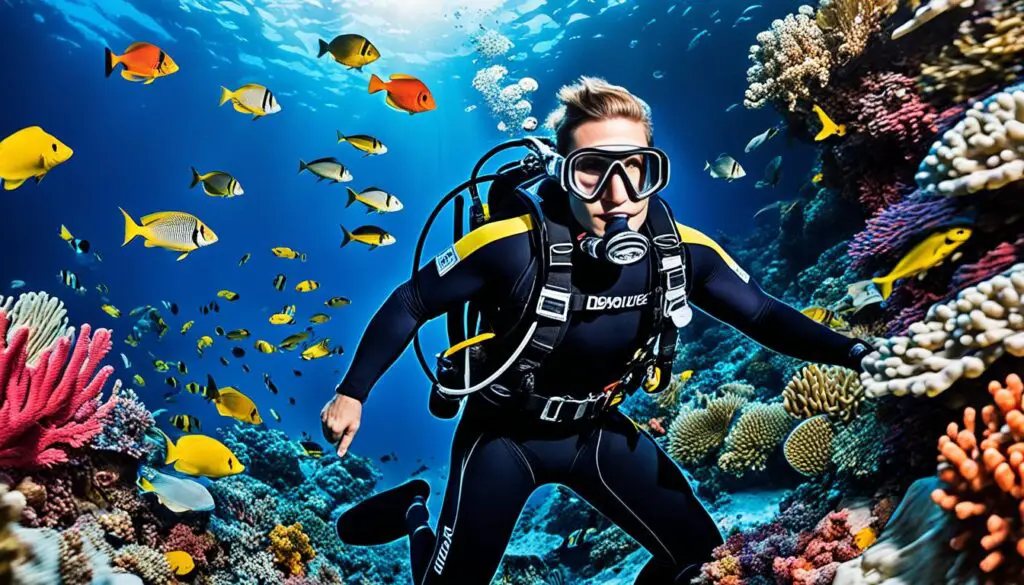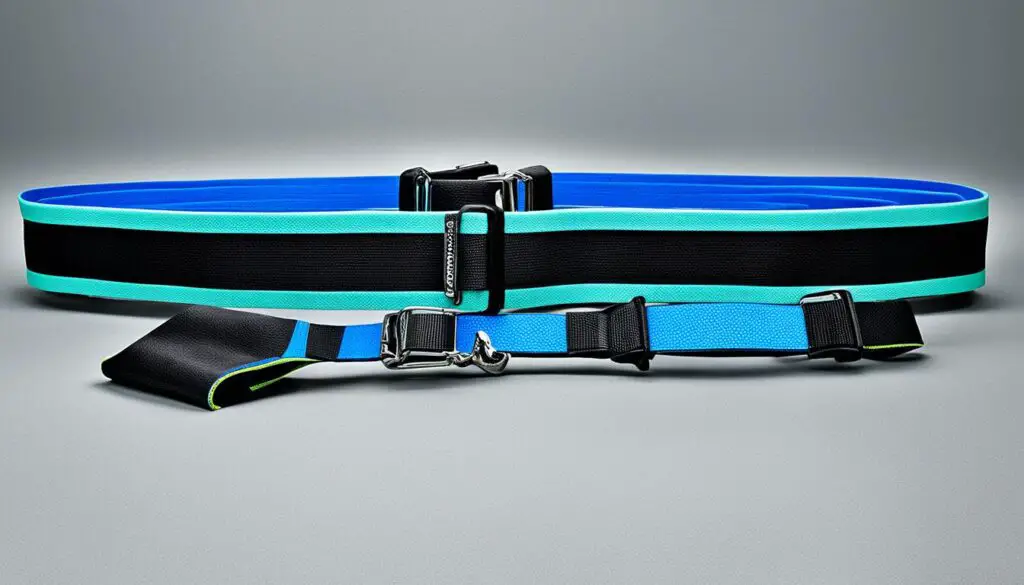As a diver, safety is of utmost importance. One crucial piece of equipment that plays a significant role in ensuring a safe and stable dive is the weight belt. A weight belt helps divers maintain proper buoyancy underwater, allowing them to adjust their buoyancy by adding or removing weights as needed.
Choosing the right weight belt is essential for achieving a secure and enjoyable dive. Factors such as body weight, the type of diving, and environmental conditions should all be taken into consideration when selecting a weight belt.
Key Takeaways:
- Selecting the correct weight belt is vital for safe and stable diving.
- Consider your body weight when determining the amount of weight to be added.
- The type of diving and environmental conditions also influence weight belt selection.
- Standard webbing belts, integrated weight systems, and weight pockets are different types of weight belts with their own advantages and considerations.
- Ensure the weight belt is properly adjusted and secured before each dive.
Factors to Consider When Choosing a Weight Belt
When it comes to selecting the right weight belt for your diving adventures, there are several factors that you need to consider. These factors include:
1. Body Weight
One of the most important factors to consider is your body weight. The amount of weight that you add to the belt should be determined based on your body weight. As a general rule of thumb, it is recommended to use approximately 10% of your body weight as a starting point. This will help you achieve optimal buoyancy and control underwater.
2. Type of Diving
The type of diving you plan to do also plays a significant role in weight belt selection. Different types of diving require different amounts of weight. For example, if you plan to do deep dives, you may need additional weights to help you descend and maintain stability. On the other hand, shallower dives may require less weight. Consider the depth and duration of your dives when choosing the weight for your belt.
3. Environmental Conditions
The environmental conditions you will be diving in should also be taken into account. The density of the water can vary depending on whether you are diving in freshwater or saltwater. Saltwater is denser than freshwater, which means you may need more weight to achieve neutral buoyancy. Be mindful of the location and the specific environmental conditions when determining the weight to add to your belt.
By considering these factors, you can ensure that you choose the right weight belt that will help you achieve the perfect balance and control underwater.

| Factors to Consider | Weight Belt |
|---|---|
| Body Weight | Approximately 10% of your body weight |
| Type of Diving | Varies based on depth and duration of dives |
| Environmental Conditions | More weight for saltwater diving, less weight for freshwater diving |
Types of Weight Belts: Pros and Cons
When it comes to weight belts for diving, there are several types to choose from. Each type has its own pros and cons, which should be considered before making a decision. Let’s take a closer look at three popular weight belt types:
1. Standard Webbing Belt
The standard webbing belt is the most common type of weight belt used by divers. It consists of a nylon webbing strap with a buckle closure. The pros of this type include its versatility and adjustability, allowing divers to customize their weight setup. However, a potential con is that it may shift during the dive, which can be a distraction or affect buoyancy control.
2. Integrated Weight System
Some diving suits come equipped with an integrated weight system, where weights are evenly distributed across the diver’s Buoyancy Control Device (BCD). This type offers a streamlined profile, reducing drag and allowing for a more comfortable dive. However, a downside is that weight adjustment options may be limited compared to other types of weight belts.
3. Weight Pockets
Weight pockets are detachable pouches that can be attached to the weight belt or integrated into the BCD. One of the main advantages of weight pockets is their easy weight adjustment and distribution. Divers can add or remove weights as needed for optimal buoyancy control. However, a potential con is that weight pockets may be less secure than other options, as they rely on attachment mechanisms.
It’s important to carefully consider the pros and cons of each weight belt type before making a decision. Your choice should be based on your diving preferences, comfort, and safety. Now, let’s take a look at a summarized comparison of the pros and cons of these weight belt types:
| Weight Belt Type | Pros | Cons |
|---|---|---|
| Standard Webbing Belt | Versatile and adjustable | Potential shifting during the dive |
| Integrated Weight System | Streamlined profile | Limited weight adjustment options |
| Weight Pockets | Easy weight adjustment and distribution | Potentially less secure attachment |
I hope this overview helps you make an informed decision when choosing the right weight belt for your diving needs. Remember to consider your personal preferences, safety, and comfort when selecting the type that suits you best.

Conclusion
Choosing the right weight belt is crucial for safe and enjoyable weight belt diving experiences. As a responsible diver, I understand the importance of considering factors such as my body weight, the type of diving I plan to do, and the environmental conditions when selecting a weight belt.
By carefully evaluating these factors, I can ensure that my weight belt provides the necessary stability and control during my dives. Whether I’m exploring deep dives or enjoying shallower adventures, the right weight belt will help me achieve a neutral buoyancy and maintain proper depth control.
It’s also essential to choose the right type of weight belt for my needs. Whether I opt for a standard webbing belt, an integrated weight system, or weight pockets, each option has its pros and cons. I’ll evaluate the advantages and considerations of each type to make an informed decision.
Finally, before each dive, I will always double-check the adjustment and securement of my weight belt. This ensures that it stays in place throughout the dive, eliminating any risks of it shifting or coming off. By securing my dive with the right weight belt, I can dive confidently, knowing that I’ve taken the necessary steps to prioritize safety, stability, and an enhanced diving experience.
FAQ
Why is a weight belt important for diving?
A weight belt is essential for maintaining proper buoyancy underwater. It allows divers to adjust their buoyancy by adding or removing weights, ensuring safety and stability during dives.
What factors should I consider when choosing a weight belt?
When selecting a weight belt, factors such as body weight, the type of diving you plan to do, and the environmental conditions should be considered. These factors will help determine the amount of weight to be added and the type of weight belt that would best suit your needs.
What are the different types of weight belts available?
There are several types of weight belts available. The most common type is a standard webbing belt, which is versatile and adjustable but may shift during the dive. Another option is an integrated weight system, where weights are evenly distributed across the diver’s BCD (buoyancy control device), providing a streamlined profile. Weight pockets are detachable pouches that can be attached to the weight belt or integrated into the BCD, offering easy weight adjustment and distribution.
How should I properly adjust and secure my weight belt?
It is important to ensure that your weight belt is properly adjusted and secured before each dive. Take the time to check that it is snugly and comfortably fastened around your waist or hips, and ensure that the buckle is securely closed. This will help prevent the weight belt from shifting or coming off during your dive, ensuring a safe and enjoyable experience.
What are the benefits of choosing the right weight belt?
By choosing the right weight belt for your diving needs, you can ensure safety, stability, and an enhanced diving experience. The proper weight belt will allow you to achieve neutral buoyancy, easily descend, and maintain depth control. It will also contribute to your overall comfort and confidence underwater.
